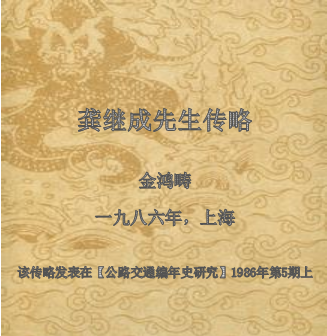
1937年铁道部派他勘测由宝鸡至成都铁路线,初以航空视察,继之陆地测量,翻越秦岭,坡陡谷深,山势险恶,选线甚为困难。时值隆冬,气候严寒,山岭气温常达零下二十多度,先生不畏艰苦,率领测队员工,坚持工作,选拟了几条穿越秦岭的比较路线,为解放后修筑宝成铁路定线工作,提供了良好基础。
1937年抗日战争爆发,是年冬。先生调任全国铁路运输工务处副处长。1938年调汉口交通部技术厅,负责新路设计。由于当时武汉已接近抗日前线,政府为沟通大西南后方交通,筹建滇缅铁路。乃于同年调先生担任滇缅铁路第二总段总段长,辖境在昆明以西70公里,地处崇山峻岭,地形复杂,他选线经验丰富,有独到之处。当时甚著名声。当地人烟稀少,物质缺乏,他力主就地取材。没有水泥,烧制红土,用红土石灰代替;没有枕木,伐树砍制。在辖境三十余公里范围内,就有隧道四座,高架桥七座,都在他的自力更生就地取材的方针下完成的。当时还有修建新疆通苏联的铁路之说,先生组织大家学习俄文和回文,在当时是难能可贵的。
1940年,日寇由越南(当时称安南)进攻侵占老街,从而切断由云南进口物质转运入川之势。当时交通部邀请先生等共商大计,先生平时熟悉地形,乃携西昌、祥云公路路线图到重庆定案。1941年调任由西康省西昌至云南省祥云的西祥公路工程处副总工程司兼会理办事处主任,主办西康省境内段长264公里的公路,以与乐西(四川乐山至西昌)公路相衔接,该路对抗战物质运输,关系重大,需要迫切。凭藉他的经验和组织能力,仅用八个月就建成通车,为旧中国公路建设史上奇迹,受到当时交通部通电表扬。
1942年滇缅铁路西段兴建,调先生担任西段第二工程处处长,驻节云南省云县。施工地段,多在瘴气严重、恶性疟疾猖獗境内,人们咸有戒心,视为畏途。而先生则以国家利益为重,毅然受命。该段工程正在进行之际,日寇陷缅甸,攻占我国滇缅边境,占领龙陵县,滇缅铁路西段被迫停工。先生又奉命调任云南呈贡飞机场施工委员会主任委员,二公里长的块石基础石灰土灌浆碎石跑道和十二座机堡工程,只用了六十三天即完成交付使用,曾获得当时政府嘉奖。
1943年日寇飞机对滇缅公路狂轰滥炸,急需组织力量抢修,乃升任先生为滇缅公路工务局局长兼总工程司并兼保密公路新工总处处长及油管工程处处长,副处长朱国洗,抢修中印公路(又称史迪威公路)由云南保山至缅甸密支那一段。其余由美军负责修建,并铺设原定平行于保密公路的原滇西公路的油管工程,以便接通印度的加尔各答港,输送进口汽油,均按时完成,保证了抗战物资的输入。先生同时还兼任四川丹竹、简阳、绵阳等飞机场工程处处长均按时完成任务。其时我国与美军会同决定准备打通滇缅公路,美军与交通部协议组成滇缅公路工程队,简称(B、R、E)。我方相应在下关成立了滇缅公路工程总队,由先生兼总队长,李温平任副总队长代行总队长职务。
在滇缅公路期间,虽然公务繁忙,但先生仍致力于自力更生,组织领导科研工作。在昆明北平研究院严济慈先生和五十一兵工厂的大力协助下,由陈庭祐工程司具体研究,经两年多时间,试制出我国第一台国产经纬仪,经1944年中国土木工程学会年会鉴定,授予先生金质奖章。其后又在昆明继续制造了一批水平仪及经纬仪,为解决当时后方缺乏测量仪器的困难,起到了积极的作用。
1944年配合远征军在滇西反攻,先生率桥梁抢修队及时修复了怒江上的惠通桥,并随反攻进展修复滇缅公路。
1945年1月初,保密公路抢修完成。一月十九日,中印公路全线通车,滇缅公路工程局副局长兼保密公路第一工程处处长沈来义随同美国试车车队到昆明报捷。油管工程于同年六月十日相继完成,通油至昆明,后又延长至呈贡、霑益、这是先生在抗日战争中打通国际交通,加强抗日力量的一项重要功绩。当中印公路通车至缅甸时,缅甸政府特制一面锈有“中緬”二字的绸旗赠给他,表示对他的赞扬。
先生一生谦虚和气,平易近人。深入工地与员工同甘共苦,克己奉公,一尘不染,事事以身作则,关心群众生活;艰苦奋斗孜孜于后方建设。由于长期担任紧急军用建设任务。呕心沥血,不顾疲劳,致罹高血压症。亲友同事,劝其休息疗养,但他总以国事为重,唯恐影响工进,不肯稍息,导致1945年十月十八日,血压突增,脑部溢血,抢救无效,与世长辞,终年四十六岁。安葬于上海虹桥公墓。保密公路上的“惠人桥”,1945年开工,1948年建成,原交通部为纪念原滇缅公路工务局局长龚继成先生的功绩,特将该桥命名为“继成桥”。解放以后沿用未改。先生生前培养了数百名中、青年工程师,解放后大多担任重要工程技术工作,培育人才,泽及后世。
先生为一代著名工程师,在旧中国堪称楷模,爰为文誌之。
A Brief Biography of Mr. Gong Jicheng
Gong Jicheng (Kung Chi-ch’eng in Wade-Giles Romanization), respectfully known in his adulthood as Junsheng (Chün-sheng), was born in July 8, 1900 in Haimen, Jiangsu. Upon graduating from Jiaotong University’s Tangshan Engineering College (now Southwest Jiaotong University), Department of Civil Engineering. In 1923, Jicheng served as an engineer at Jinpu Railway and Shenhai Railway. In 1929, he was assigned to be the leader of a survey team for Hangjiang Railway (later extended as Zhegan Railway) before becoming division-in-chief of No. 1 Grand Division after the project went into construction. During this project, Jicheng assisted in the survey of Qiantang River Bridge and drew up overall and detailed plans for the railway construction. In 1933, Jicheng took part in a Sino-Swedish scientific exploration in Xinjiang led by the Swedish explorer Sven Anders Hedin. The expedition lasted for two years, during which they overcame great difficulties to conduct surveys for two routes: one for a railway from Lanzhou to Xinjiang, the other for a north-south highway across the Tian Shan (Tien Shan) range. After the expedition, Jicheng was transferred to the Engineering Bureau of Longhai Railway and appointed as the division-in-chief of No. 1 Grand Division of Longhai Railway, responsible for its divisional construction from Xi’an to Xingping. The project included the erection of a 10-arch steel plate through-bridge more than 400 meters long over the Wei River in Xianyang. To meet the project deadline, Jicheng innovatively employed a high-pressure hydraulic jet to deal with the technical problems posed by the cobblestone riverbed. In 1937, Jicheng was designated by the Ministry of Railways to conduct another survey for a proposed railway to run from Baoji to Chengdu. This was the first time the method of railway aero-surveying was adopted in China. Jicheng led the team in surveying and comparing several lines crossing the Qin Ling (Tsinling Mountains). The rich and valuable mapping data they recorded greatly aided the location and construction of Baocheng Railway during the ensuing decade. After the survey, Jicheng became the deputy director of the Maintenance Department for National Railway Transportation. In the following year, he was transferred to the Technology Bureau of the Ministry of Railways, where he was in charge of the design work of the new routes. In 1939, he was appointed as the division-in-chief of No. 2 Grand Division of Dianmian Railway, an international railway that planned to link Kunming with Lashio, Burma. (The project began construction in 1938 but was never completed due to the Japanese invasion.)In 1940, Jicheng became the deputy engineer-in-chief of the Engineering Department of Xixiang Road, responsible for a 264km divisional construction running through Xikang Province (now the west of Sichuan and the east of Tibet). The total 525km Xixiang Road played a significant role for the transportation of much-needed war goods during the anti-Japanese War. Jicheng took only eight months to complete the assigned task, earning a circulated commendation by the Ministry of Communications for his careful planning and outstanding organization. In 1942, the Japanese overran Burma and seized Longling, a border county in Yunnan. The west division of Dianmian Railway was forced to a standstill; the Burma Road (from Kunming to Lashio) was also closed. As a result, all supplies to inland China from the outside world had to be transported by air. In the winter of 1942, Jicheng was appointed as the Chairman of the Construction Committee of Chenggong Airport in Yunnan Province and was responsible for the construction of a 2km airfield runway and 12 hardened aircraft shelters. The project was completed and put into service within 63 days. In 1943, the National Government and the Allies decided to reopen the Burma Road for the counterattack. As director general of Dianmian Railway and the director and the engineer-in-chief of the Maintenance Bureau of Burma Road, Jicheng was tasked with recovering the sections of the road that had been destroyed. His next project, according to a decision made by the National Government and the Allies, was to take part in building an international passage linking China and India. In this project, Jicheng took charge of the divisional construction of Baomi Road (from Baoshan, Yunnan to Myitkyina, Burma), which was part of the Sino-India Road (also known as the Stilwell Road or the Ledo Road). At the same time, he was in charge of the Baoshan-Myitkyna oil pipeline project, where an oil pipeline was laid parallel to Baomi Road to support the military supplies. In the same year, Jicheng was promoted to the position of engineer-in-chief of the Engineering Committee under the Central Military Commission. He was also the superintendent of the Engineering Department of Danzhu, Baishiyi, Jianyang, and other Military Airfields. In two years, with the assistance extended by Yan Jici of the National Academy of Peiping in Kunming, Jicheng designed and, after many trials, successfully produced the first theodolite in China. He was awarded the gold medal by the Ministry of Communications for making of the instrument, which greatly improved surveying work in war time. The Sino-India Road opened for transportation on January 19, 1945. The oil pipeline was also put into service on June 7, 1945, delivering oil to Kunming, Chenggong and other places. Gong Jicheng died of a cerebral hemorrhage in Kunming in November 22, 1945.